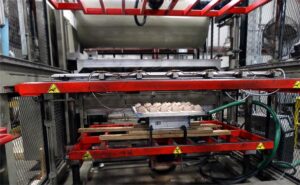Thermoforming involves heating up large sheets of thermoplastics and shaping them around a custom tool…

Thermoforming custom plastics is a time-efficient, cost-efficient way to manufacture parts and components, especially large pieces and those with lower order quantities. Tooling is quick to fabricate, and the process itself is generally straightforward. However, that doesn’t mean that problems and flaws can’t occur. One of the most common problems in thermoforming is webbing and wrinkling on the plastic sheet, which can cause both functional and aesthetic issues. To learn more about what causes this issue and how we prevent it, our thermoforming company is taking a closer look at webbing in thermoformed plastics.
What Is Webbing in Thermoformed Plastic?
First, let’s take a look at what webbing actually is - basically, it’s unplanned, unwanted wrinkling that appears in the plastic as it’s stretched over the mold. While it may seem like more of an aesthetic concern, affecting the overall look of the part, component, or product, this can actually be much more serious. There is often very little to no “wiggle room” so to speak in design and the finished product, and unexpected wrinkles cause problems including preventing a component from fitting correctly into a completed product or causing added friction against other components which can reduce lifespan and affect performance.
Common Causes of Thermoformed Plastic Webbing
We tend to see this problem most often in vacuum forming, a type of thermoforming in which the plastic is heated and fitted over the custom tool. A high powered vacuum removes any air between the sheet and the tool, drawing it tightly and creating the necessary shape. The simple cause of webbing is that the plastic stretches around the tool inconsistently - think of laying a piece of fabric over a shape and pulling it taut - the folds you see are similar to how webbing in plastic occurs.
So, what leads to the plastic stretching and pulling in such a way that it wrinkles instead of lays smoothly against the tooling? That is where several variables come into play:
- Plastic is overheated and stretches too much in certain areas;
- Inconsistent suction so the plastic sheeting doesn’t draw against the tool evenly;
- Excessive amount of plastic sheeting so it doesn’t fit smoothly and tightly against the tool;
- Minimal draft angles creating a curve that is too sharp.
- Using a male mold where the mold extends upward through the sheet line and the plastic lays over the shape.
Preventing Wrinkled or Webbed Plastic in a Finished Product
Now that we know what causes the problem, let’s look at how we prevent this from happening in the first place so we get the smooth, accurate piece our customers need.
Turning Down the Temperature
This is the easiest problem to solve where the manufacturer simply has to turn down the heat on the equipment so that it’s still malleable but not overly “stretchy.”
Adding Vacuum Vents
If the problem stems from the vacuum flow not being consistent, the issue most likely comes from vacuum vents. Either the existing ones need to be cleaned out to ensure proper negative air flow, or additional vents can be added to allow for uniform suction.
Trimming the Plastic Sheeting
While it may seem easy to simply trim away the excess, using too much plastic to start can gather and wrinkle. Like overheating the plastic, this is a simple solution where you just use a smaller sheet to begin with.
Increasing Draft Angles
While this is more often an issue in injection molding, adding more of a taper and decreasing the sharpness of the angle can create a smoother shape and minimize or eliminate the webbing where the horizontal and vertical parts of the plastic meet. This issue is often corrected in the design and engineering process, so if this is the problem, the tooling may need to be redesigned.
Using Female Tooling
While male tooling is much less expensive, if no other solutions fix the webbing, it may be necessary to use female tooling, where the shape is below the sheet line and the plastic is pulled downward into the mold. While female tooling is more expensive, draft angles can be significantly sharper as the part shrinks away from the mold during cooling and corners can be much tighter while still ensuring a smoother surface.
Trust Your Custom Plastics to Advanced Plastiform, Inc.
At Advanced Plastiform, Inc., we have the experience and knowledge to understand how to get the best results before we have to troubleshoot. Our customers know they can count on us for accurate, identical plastics at a low per-unit cost with a short turnaround time.
We work with all types of industries in the Southeast and Mid-Atlantic, including North Carolina, Pennsylvania, Maryland, Tennessee, Georgia, and Virginia. To learn more, reach out to our team today.

